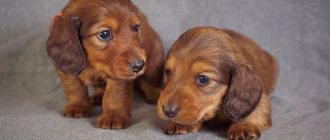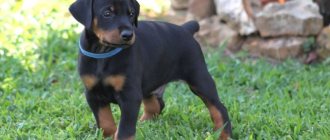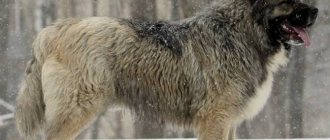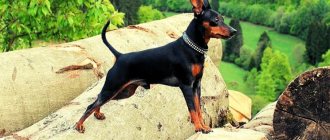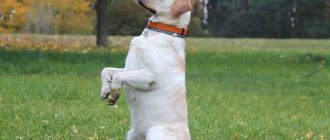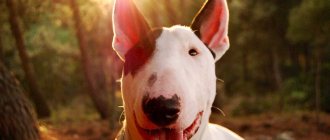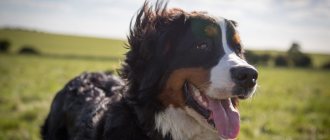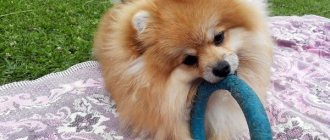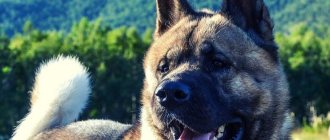Raising a dog is about developing correct behavior. This is the basis for successful training. Training is a set of activities aimed at training specific teams. It is necessary to start raising a puppy from the very first days of his appearance in the house. If you work with your pets from a very early age, then you are on the right track.
The Miniature Schnauzer (or as it is also called the Dwarf/Miniature Schnauzer) is a breed of dog developed in Germany. He amazingly absorbed: high intelligence, affection and playfulness. With a miniature schnauzer in your home, you will never be alone.
- Country of origin : Germany
- Height at withers : female: 30–36 cm, male: 30–36 cm
- Weight : female: 5.4–8.2 kg, male: 5.4–9.1 kg
- Lifespan : 12-15 years
- Use : companion dog, rat catcher
- Other names : dwarf schnauzer, miniature schnauzer
Raising a Miniature Schnauzer
In order for you to have a kind, affectionate and obedient dog in the future, you should not spare effort in raising it. A miniature schnauzer needs to start explaining the rules of living together from the first minutes of being in the house.
First, be sure to train the puppy to his place. It should be located in a cozy and well-lit place. For raising a miniature schnauzer puppy
The kitchen, corridor and bathroom are strictly contraindicated. It is best to give it a place in the living room away from heating devices and drafts. The puppy should feel that in his place he is protected from all troubles. Therefore, never hit or punish your pet if he hid from you in his corner.
An important point in puppy socialization is a loyal attitude to the leash and collar. The dog should not feel discomfort when wearing them. You can accustom him to a collar from the age of 2-2.5 months. To distract your puppy's attention from the uncomfortable collar, play with your pet, making him forget that he has a new object on his neck. In general, raising a Miniature Schnauzer puppy
must be built on mutual trust and kindness. Try to use punishment, especially brute force, as little as possible.
This is very important during leash training. Often the dog resists and does not want to go. Do not drag your puppy along with you. Better let go of the leash and let him drag you. Let the dog get used to the fact that he is not completely free. After some time, he will calmly walk on a leash on his own, without twitching or resisting.
Gradually show your pet more and more new places. Introduce him to a crowded street, public transport, teach him not to react to strange dogs and cats. You must raise your dog in such a way that you won’t be ashamed to go out with him in public.
Miniature Schnauzer training
Training a miniature schnauzer at home is a very exciting process. This dog loves attention to itself so much that it will happily carry out any commands, just to please the owner, and he will stay with her longer. At the same time, training a miniature schnauzer puppy
requires some skill on the part of the breeder. These dogs are capricious and obey only those who, in their opinion, are stronger than them. If you give even a little slack, the miniature schnauzer will immediately take advantage of the opportunity to take control of the situation.
Start training your miniature schnauzer yourself
needed at an early age. Before reaching one year of age, the dog must already accurately execute a basic set of commands. At a later age, it will be more difficult to teach this to a miniature schnauzer.
Further training for service or as a companion dog can take place under the supervision of an experienced dog handler. If you feel that the contact between you and the dog is quite strong and the pet is ready to obey you unconditionally, then you can do without outside help.
The main thing is not to forget that miniature schnauzers are ambitious dogs, capable of not only excellent learning, but also showing enviable perseverance. Therefore, the owner must immediately recognize the pet’s mood for work, and under no circumstances force him to do something that the dog does not want. Both parties should enjoy the training.
If you decide to adopt a dog and your choice falls on a faithful and intelligent miniature schnauzer, you need to choose the right little miniature schnauzer and raise him to be a devoted pet. This is one of the most beloved breeds in the world, it has a sweet appearance and at the same time a fearless character, is easy to train and is sensitive to its owner.
Vaccinations and susceptibility to disease
How long miniature schnauzers live depends on several factors. This is influenced by the dog’s genetics, the conditions under which it is kept and the presence of chronic diseases. On average, the life expectancy of miniatures is 14-15 years.
In order for the miniature to live a long life, it is regularly treated for parasites. Helminths disrupt the functioning of the digestive tract, fleas cause dermatitis, and ticks carry Lyme disease and deadly piroplasmosis.
Although schnauzers have good immunity, the breed is prone to certain pathologies:
- epilepsy;
- hypothyroidism;
- melanoma;
- atopic dermatitis;
- lipoma;
- diabetes.
In order not to expose the miniature to the risk of dying from infections, he is regularly vaccinated. Schnauzer vaccination is carried out according to dates using a complex drug that provides protection:
- from leptospirosis;
- viral hepatitis;
- carnivore plague;
- parvovirus enteritis;
- rabies.
The first vaccinations for miniature schnauzer puppies are given at 8-9 weeks. After 21 days, vaccination is repeated. In the future, dogs are vaccinated once a year.
Description of the breed
The Miniature Schnauzer is a breed with the smallest build in the entire Schnauzer group. Apart from its size, the dog is no different from its large counterparts, for example, from the miniature schnauzer. The Miniature Schnauzer is smart, hardy and active. This is a very active breed, so owners must understand that such a puppy will not lie down on the couch and rest for days. He will need daily training and attention. With proper upbringing and proper training, a baby of this breed will become a faithful and brave companion.
An adult miniature schnauzer is a small dog with a strong, stocky build and a “square” shape. There is no tenderness in his appearance
, inherent in decorative breeds. This is a brave guard and intellectual of the dog world, a small but serious breed. If you're looking for the character of a big dog in a small body, go for the Miniature Schnauzer.
Breed characteristics:
Regardless of the color of the coat, the miniature should have a mask on its face that is several tones darker than the main color. Acceptable colors of a mini-schnauzer:
Read also
One of the characteristic features of the breed is health. A cheerful temperament and activity ensure that the dog rarely gets sick. However, this quality also has a downside.
One of the main characteristics of this breed is its coat. Tough, wire-like, it reliably protects the dog from skin damage and does not shed on its own.
In the Schnauzer family, Miniatures are the smallest representatives. This makes the breed very convenient for keeping in a city apartment. carried out in many regions of the country. This is due to the unprecedented popularity of the breed, its convenience and cheerful disposition of dogs.
Gallery: miniature schnauzer puppies (25 photos)
Character of the miniature
The Miniature Schnauzer combines two extremes: a funny appearance and a sense of self-esteem. This is a proud dog with high self-esteem. The power of his temperament can be seen in everything: his manner of movement, habits and barking. This is not a soft terrier or an indoor Spitz
.
At first glance, it may seem that this is a cute couch dog whose purpose ends with wearing pink overalls. But when you meet him, you will be amazed at how different the appearance of the breed is from the powerful inner core of this dog. This is an ardent defender of his family, ready to rush at the offender if necessary.
This does not mean that the main character trait of the Miniature Schnauzer is aggression. This is a very smart breed, therefore a well-mannered dog will not get into a fight unless clearly necessary. The whole meaning of its existence is focused on the owner. This is the embodiment of loyalty and devotion. You won't find a more attentive pet.
In games, he does not refuse the company of other dogs. The miniature dog has a remarkable feature that is more typical of large breeds: he is not afraid of large dogs and treats small ones with respect.
The desire to act as a protector is observed in the breed from a very early age. But this quality requires careful cutting. In order to eliminate uncontrollable attacks of aggression in the future, the upbringing of the Miniature Schnauzer must be strict. Such dogs know how to obey, but they willingly do this only with those who are stronger than them . The owner must be an authority and leader in the “pack”
.
The Miniature Schnauzer needs a lot of attention. This is a dog with enormous dedication, which requires reciprocity from the owner. Without proper attention and love, a pet can turn into a disobedient and aggressive dog. For peace of mind, the miniature needs constant satisfaction of the inner fighter and guard. Let him be your friend and accompany you.
Choosing a puppy
It is recommended to start purchasing a puppy by examining its parents. As a rule, more attention is paid to the bitch rather than the dog. Before purchasing, experts recommend visiting an exhibition and observing the dog you like. Pay attention to her habits. Look how she acts
and how well it works with the owner.
Having chosen a representative of the breed, talk to its owner. You should pay attention to the conditions of detention: is this a kennel or does the owner keep only one dog? Where do animals live and what do they eat? All these factors directly affect the health of your future pet.
Miniature Schnauzer puppies begin to be weaned from their mother at two months. By this age, they are already able to demonstrate the rudiments of temperament. After visiting the nursery, ask the owner to open the enclosure. Let the cubs prove themselves.
Despite their external similarity, all puppies will be completely different. Choose an active and mobile one. The little miniature should show interest in a stranger. Under no circumstances should there be unreasonable aggression, as well as manifestations of cowardice.
Competent breeders, as a rule, select the most promising puppies from the litter. With proper training, such dogs grow up to be real champions. They cost more than others, so it is advisable to buy them only with a clear purpose
achieve success at exhibitions or competitions.
You need to select your puppy no less carefully if you plan to become a breeder in the future. Only first-class representatives of the breed are allowed to breed. Their ability to produce high-quality offspring is also influenced by previous generations, so you should definitely familiarize yourself with the puppy’s pedigree.
The external similarity of all puppies in the litter indicates competent breeding work and careful selection of pairs for mating. If half of the babies are related to marriage, then there is a possibility of transmission of low-quality genes from the bitch to the offspring.
If you are not sure about your choice, seek advice from a specialist. He will help you choose a puppy in accordance with your wishes and future goals.
Which gender is preferable?
Bitches and males have different temperaments, so when choosing the gender of your future pet, consider the following features:
- Males are more independent. Their appearance is impressive, but their character is cold and indifferent. Males do not like affection; they cannot be carried in arms. Males are characterized by independence and efficiency. It often happens that the call of nature is placed above the interests of the owner, so it is not always clear who is walking whom;
- Bitches are more disposed towards the owner. They prefer to spend time next to their owner, sleep on the couch and play with children. Girls are softer and more flexible. They get along well with other animals. Estrus occurs twice a year and is tolerated calmly.
Baby's appearance
When choosing a puppy, you should pay special attention to its appearance. Its appearance should contain a number of characteristic features
.
In addition to the requirements of the standard, be sure to pay attention to the puppy’s health condition. The animal must be active, have a good appetite and an attractive coat. The glossy coat and average body condition are an advantage. In no case should there be a bloated abdomen, malocclusion, or pallor of the mucous membranes of the mouth.
Raising a miniature schnauzer is based on mutual work. The dog must learn to work in a team, but at the same time clearly understand who is the “leader” in the pack. The owner takes leadership and commands the process in any business.
The puppy should grow up with a clear understanding of who his owner is and with a willingness to protect that owner. To strengthen the dog’s persistence, it is necessary to periodically play along with it, giving in to training. Let the dog win one
and five stick battles. But don't do this too often. Your pet may think that you are weaker or more cowardly than him. When you lose on purpose, remain a leader.
The issue of leadership in raising a little miniature dog should be raised from the very first days. Any inappropriate actions, such as biting, must be stopped immediately. If the puppy has crossed the line, try to distract him. If this does not work, use an impromptu punishment: lightly slap the puppy on the back or snap your fingers in front of his nose. It is highly undesirable to use force, but you simply have to demonstrate your power.
If inappropriate behavior is not stopped, the puppy can grow up to be a “dictator”, and his outbursts of aggression can be directed at the household and the owner, which in itself will be dangerous.
The first training of the little miniature should be carried out in quiet, deserted places. In such an environment, the animal will be able to concentrate, and conditioned reflexes will be developed faster and more reliably established. Once the initial commands are mastered, they can be worked on in a more dynamic environment.
The main training course begins at the age of 8-10 months. Before this period begins, the owner’s task is to develop conditioned reflexes to basic commands (“fu”, “sit”, “place”, knowing his nickname). The puppy must obey without fail
requirement and in any situation.
Despite its miniature size, the miniature schnauzer
- not a decorative breed and requires thorough
training
. His ancestors specialized in protecting rural barns from rodents and did their job brilliantly. The miniature may be the smallest in the world, but it is a real service dog and will only obey you if you demonstrate to him your seriousness and consistency.
Maintenance and care
The puppy's first walk takes place 21 days after the vaccine is administered.
Until the child reaches six months, the walk lasts 15 minutes, 5 times a day. Over time, the number of exits must be reduced and the duration increased. It is enough for an adult dog to walk for an hour, but 2-3 times. Despite the fact that walking miniature dogs can be difficult, you cannot leave them without street activity.
The eyes, ears and nose should be checked constantly. Discharge, redness, rash are unacceptable. If the ears are not cropped, the hairs must be removed. This allows air to circulate in the ear canals. With its deficiency, otitis media often occurs.
To remove plaque from teeth, remove tartar and strengthen gums, you need to give your pet bones, biscuits or chew toys once a week. The home method also shows the effect:
- Gauze is wrapped around the finger;
- Soak in solution (soda, yarrow, peroxide). Equal parts are taken;
- The solution is evenly distributed onto the animal's teeth and gums.
When the pet gets used to it, brushing the miniature's teeth is easy and quick.
Miniature Schnauzer puppies, especially in the first months of their life, require careful care. We'll talk about the basic rules for keeping puppies below.
Caring for a miniature schnauzer puppy
Grooming
The coat must be brushed twice every 7 days. Treatment begins with the limbs. Then use a coarse brush to walk along their entire length, then the armpits, abdominal area, back and head last. It is not advisable for a miniature to take a shower often. If you use a detergent frequently, the coat will become dull, the shine will go away, and brittleness will appear. It is advisable to wash it if the coat is very dirty and before visiting the hairdresser.
Miniature Schnauzer Grooming Guide
The event is called trimming. Without this method of care, the dog's fur will be in clumps and without shine. The first trimming is needed at 7-9 months. Dogs required for shows are processed 48 hours prior to the show. Miniatures not related to competitions are plucked before molting - once every six months. If the procedure was carried out correctly, then even during the period of hair loss there will be no fallen hairs.
Miniature Schnauzer trimming step by step
The hair in the head, neck, lower part of the sternum and ears is not touched, but only trimmed with a clipper using special attachments. Special scissors are also used.
Nutrition
Miniature Schnauzers tend to get fat, so overfeeding them is not recommended. The general rules for feeding the animal must also be applied to this breed:
- It is not allowed to give food from the table;
- Compliance with the regime;
- Balanced diet.
Careful planning of your zwerg's diet will help avoid liver problems
Miniatures have liver problems. Therefore, they should not be given sweets, flour products, fatty/fried foods, or smoked bones. Until the puppy is 6 months old, you need to feed him 5 times a day. Then the number of feedings is reduced to 2. Nutrition also affects the color of the pet. If there are few vitamins in the diet, the coat of miniature dogs becomes dull.
Where to begin?
From the moment a puppy appears in your home! A baby is much more trainable and will obey more willingly than an adult dog that is being retrained. At the first stage, training is closely related to education. To get started you need:
- train
a small
miniature schnauzer
to use the toilet at home - he cannot be walked until the end of the vaccination quarantine; - teach him to respond to a call and let him get used to the nickname;
- teach simple commands.
Miniature Schnauzer
- an active and smart breed, but they are jealous and willful, and when
raising
you should not give in to slack. Try to develop the qualities necessary for your pet to respect you. The dog will listen if you are calm, fair and persistent. You can’t punish your child for not understanding you right away - gently achieve what you want over and over again. It is better to train a puppy in a playful way - it will be understandable to him and pleasant to you.
Health
Miniature Schnauzers are famous for their health. It seems that their optimism and innate love of life repel disease.
Representatives of the breed are predisposed to eye diseases that manifest themselves in adulthood, allergies, skin inflammation, benign and malignant tumors.
Most infectious diseases can be avoided by up-to-date vaccinations for your four-legged friend.
Mandatory procedures should include worming and ridding your pet of external parasites.
Basic principles
Reward is an important tool for training a miniature schnauzer.
. When teaching your dog commands, have a treat ready and reward your dog every time he performs them correctly. Speak kindly - he understands intonation perfectly and wants to please you; this works to your advantage when learning. There are recommendations that must be followed from the first day of living with a puppy.
- There are probably places in the house that he is not allowed to go (like your bed). There should be no exceptions to this rule. If you are inconsistent in your prohibitions, the dog will notice this and conclude that the rules you have established can be ignored.
- You need to praise and scold at the right time - that is, immediately after the action has been performed (for example, following a command or, conversely, disobedience), before the dog’s attention switches. Otherwise, an associative connection between the action and your reaction will not be created.
- A miniature schnauzer
, even
brought
up strictly, can be jealous or aggressive towards children and other animals. While he is small, this can be funny, but such behavior cannot be positively reinforced. If you show your puppy right away that you are unhappy with his impulsiveness, you will avoid many behavior problems in the future. - Kids respond happily to affection, love to play and trust everyone who takes the initiative to communicate. This should not be encouraged. The main people for a dog are the owner and his family; It is important that she listens to you. It is better to instill useful habits in your miniature: for example, he will be happy to guard your bag.
When training a miniature schnauzer
Constancy is required of you. Daily gentle exercise will give much better results than a one-time, but excessive load. “Repetition of what has been covered” is the key to successful memorization. If the dog has become inattentive and lost enthusiasm, most likely he is just tired, and you need to give him a rest before the next lesson.
Sit next to me, give me your paw
A basic set of commands can be taught to a puppy from a very early age (3-4 months). Miniatures are receptive and smart, so it takes a little repetition for the baby to understand what they want from him. Just a few daily lessons and he already understands:
- "sit";
- "to me";
- "place";
- "lie";
- “give me your paw”;
- "take a walk";
- "near";
- "it is forbidden".
First, you will need physical pressure to ensure that the dog performs the desired actions: when saying “lie down,” you will have to press on the back with your palm, and when asking for a paw, you will lift it yourself. But soon the puppy will learn to obey words, and your intervention will no longer be required. At first (until the process is brought to automaticity), after a successfully executed command, you need to reward him with a treat.
Important: the dog does not understand speech, but remembers a set of sounds. All commands must be pronounced in the same form - do not say “sit” or “sit down”, this will cause confusion.
Be careful with the “fu” command - do not use it unless you are sure that you can physically influence the dog and stop the unwanted behavior. He will not obey without the confidence that your “fu” is backed up by action. But “fetch” is a command that suits an active miniature like no other: he will be happy to bring you balls and frisbees.
Gradually make training
: if you started it
at home
, start going outside - first to a deserted place, then to a public one;
As a rule, miniature schnauzers
quickly adapt to new environments. But it is important to be sure that the dog will obey you not only in usual, but also in unexpected situations.
Miniature Schnauzers
with a good exterior they successfully participate in exhibitions;
if you plan to show, train your dog to stand
. The pet must be ready to be examined by experts, without resisting showing its teeth and allowing itself to be touched. It is convenient to accustom your dog to stand with the help of a locking trainer, not forgetting to praise him for calmness and obedience and reward him with treats.
Care and maintenance of an adult dog
The miniature is not suitable for enclosure life. And it’s not so much the smallness of the dog, but the dislike of loneliness. A miniature schnauzer, deprived of the attention of its owners, begins to get bored and may become depressed.
Caring for a miniature dog is no more difficult than caring for a dog of another breed. The main thing is to teach the dog a calm attitude towards the necessary procedures from an early age.
Caring for a miniature schnauzer comes down to proper feeding, regular walking and basic hygiene.
The right diet
The owner independently decides what to feed the miniature schnauzer. When choosing the type of food for your dog, you should be guided by your own convenience. While eating, miniatures often get their beard and mustache dirty. Therefore, among the owners of dwarf schnauzers there are many fans of ready-made food.
Drying for miniatures should be premium or super premium.
It is important that the dog food does not contain corn, soy, wheat, preservatives, dyes or other dubious additives. The daily drying rate is determined according to the table on the packaging, taking into account the age and weight of the schnauzer
With a natural type of feeding, the diet is designed so that the following products are present in the miniature’s menu:
- meat (poultry, beef or lamb);
- vegetables (zucchini, pumpkin and carrots);
- offal (beef liver, heart and tripe);
- cereals (rice, buckwheat and oatmeal);
- fermented milk products (kefir, yogurt and cottage cheese);
- sea fish;
- eggs.
You cannot feed your dwarf schnauzer pork, potatoes, onions, baked goods, sausages and chocolate. Salty, spicy, smoked, fatty and fried foods are not suitable.
Leftovers from the master's table are also not the best food for a miniature schnauzer.
Walking and physical activity
The little miniature is by no means a decorative house dog, willing to wear a diaper and lie on the sofa. He needs regular walking and adequate exercise.
While you are outside with your miniature schnauzer, you can play ball, jump over low obstacles, or practice commands.
Training and education
Miniature Schnauzer training should begin when the puppy is 3-4 months old. Until this moment, the dog must learn the rules of behavior in the new home and get used to its nickname.
Before training a miniature schnauzer, close contact is established with the puppy, because without trust there will be no result. It is better to start training with your dog for 5-10 minutes, gradually increasing the time. If the miniature is tired and cannot concentrate, the lesson is stopped.
At first, the miniature schnauzer is rewarded with a treat or verbal praise for each task completed.
A prerequisite for comfortable coexistence with a dwarf schnauzer is socialization. To do this, after the end of quarantine, the dog is often taken out to busy places so that the dog learns to calmly deal with irritants.
Care and hygiene
Ear and tail docking for dwarf schnauzers is performed by a veterinarian. This is done in puppyhood.
The thick and coarse coat of the miniature is combed weekly with a slicker brush and a single-row comb with round teeth. Before the procedure, the dog's hair is moisturized with balm, spray or conditioner. Every 2-3 months, the Wirehaired Miniature Schnauzer needs trimming.
Plucking is done manually or using a stripper and trimmer.
The dwarf schnauzer is bathed no more than 2-3 times a year using special shampoos. But the miniature's mustache and beard are washed after each feeding.
No less attention is paid to the eyes of a dwarf schnauzer. They are wiped daily with a cotton swab moistened with boiled water or chamomile decoction.
The miniature's ears are regularly inspected for the presence of suspicious discharge and, if necessary, cleaned of accumulated dirt.
A small schnauzer's claws wear down naturally. If the miniature walks on the asphalt a little, they are shortened with a nail cutter.
The Miniature Schnauzer's teeth are periodically brushed with a non-foaming paste applied to a special brush with soft bristles. To prevent plaque and stone, the zwerg is given large beef bones or chewy treats.
Voice!
Miniature Schnauzers
love
to bark
.
This can be useful when the pet acts as a guard or warns of danger. If you think that the dog is too unrestrained, you can teach him to voice only in special cases using methods that are already familiar to you. Stop barking
when it is undesirable (for example, on the street when your
Miniature Schnauzer
meets another dog), and during training, give the “voice” command, encouraging its execution with a piece of food.
...or just a click
Buy a clicker - this simple device will make your life much easier. The technique is based on positive reinforcement and was originally created for training dolphins. The clicker makes a clicking sound when pressed - your task during the training process is to strengthen the connection between the click and the treat. This way you will teach your dog:
- approach you on command;
- do not pull on the leash;
- bring things;
- carry out any commands and even tricks.
Since miniature schnauzers
They have acute hearing and
to train
using a clicker. The sound produced is quiet and short, does not mix with street noise and helps to develop a quick response to commands.
History of appearance
It would take a long time to list breeds about the origin of which there is no reliable information. These breeds include miniature schnauzers, whose history is shrouded in the fog of time.
It is known for certain that the homeland of these dogs is Germany. Initially, only medium-sized schnauzers existed in the country - middle schnauzers - from which large and miniature dogs subsequently evolved. Schnauzers of that time were a working breed; they were excellent guards and helped the owner get rid of rodents.
Miniature Schnauzers appeared much later. In the process of long breeding work, schnauzers were crossed with poodles, pinschers, and spitzes. The goal of the breeders was to breed a miniature copy of the schnauzer with full preservation of all its working qualities.
"Zwerg" translated from German means "gnome". And “schnauzer” literally translates as “muzzle.” This is how we get the original name of the dog “gnome face”, emphasizing the specific face with a beard.
1890 was the debut year for Miniature Schnauzers. The dogs, which appeared at the exhibition for the first time, became a real sensation. The breed standard did not have to wait long; it was developed almost immediately.
For more than a hundred years, dwarf schnauzers were only the property of Germany. Only in 1928 did the first representatives of the breed come to England. Miniature Schnauzers came to our country from the USA in 1974.
The periods of the World Wars, First and Second, were very difficult for miniature schnauzers. Over the years, the breed almost disappeared; only the efforts of enthusiasts helped to preserve it.
So what is next?
Miniature Schnauzer
, like any service dog, not only home
training
;
you can safely enroll him in school
. The school will not only improve obedience skills, but also correct behavior if you missed something, or the dog came to you as an adult and has gaps in education. Even if it is not possible to regularly visit a canine center, you can get advice from professional trainers - this will help you achieve mutual understanding with your little friend.
One of the biggest misconceptions of many owners of miniature dogs is the attitude towards the dog as a small, decorative creature. No, everyone has read and knows that schnauzers, even such small ones, are the most service dogs there are. Just looking at the little cheerful little animal, some people are overtaken by a kind of selective sclerosis and the owners are in no hurry to burden the baby with upbringing and training. And why, when he already understands everything!
No doubt, miniatures are really very smart. Sometimes it even seems that they are able to read your thoughts, and not only that. They also quickly pick up on their owner’s weaknesses and use them very competently. And if the miniature schnauzer’s training was not started on time, you risk very quickly joining the ranks of the most well-mannered owners, and your favorite dog will become the teacher.
Not happy with this prospect? – Then we forget about the size of the pet and start training from the very first days. Moreover, you can’t get away with a banal set of commands for obedience. Schnauzers must be “in business.” Some of them consider it their duty to protect you, others – to chase cats and pigeons. Miniature Schnauzer training is an excellent alternative to such activities, and your pet will most likely like it.
What can you teach a miniature?
Owners of miniature schnauzers sometimes don’t even suspect what a smart and versatile dog they got. Small, not intrusive, loyal, easy-going, non-shedding, plus unusually smart. You can teach a miniature anything! General obedience commands, jumping over a variety of barriers, circus tricks, as well as the skill of searching for and carrying objects, guarding your belongings, etc.
Naturally, the miniature guard does not look as impressive as a Giant Schnauzer or a Doberman, but he will carry out his mission as seriously as they do.
If you are a supporter of a healthy and active lifestyle, then you can safely engage in sports with your pet. Agility and frisbee dog, freestyle and flyball are excellent activities for the miniature dog and its owner.
Miniature Schnauzer training can be done by absolutely anyone and with any skill set. The only thing you shouldn’t get carried away with is serious traction loads. For example, carrying a sled, even with a small child, is not for a miniature. Although he will probably try his best here too.
Where to begin?
It is best to start training your little one with the simplest commands. And here your main goal will be to set the dog up for work, to let him understand that training is not a game. The miniature is not a Yorkie, training with him does not require special delicacy, but there should not be any rudeness. Everything is serious, but friendly. And don’t skimp on your emotions when praising. Remember, all his efforts are for you and your approval is the highest reward for your pet.
The easiest commands to master will be “Sit!”, “Come to me!” and “Give me your paw!” The miniature can learn them in just a couple of lessons. The main thing is to follow a simple algorithm. They gave the command - they immediately forced the dog to do it (they sat him down, took him by the paw, pulled him towards him with a leash) - he praised him - he gave him a treat. And repeat this five times. Next is verification. Let your pet try to perform the action himself. It turned out great! Don't be stingy with praise. No - five more repetitions.
Very often, owners relax after their pet’s first successes. He seems to have already understood everything, why repeat it? However, in the case of a miniature dog, it is very important to make it clear to him that the command must always be carried out, under any circumstances, and the first time. Otherwise, the little sly one will very quickly begin to listen to you when it is convenient for him, and in other situations he will pretend to be deaf. Therefore, if you have already started teaching your schnauzer a command, do not stop the process until you bring the skill to automatism.
Training a miniature schnauzer also does not need to be rushed. Start teaching new commands only after the dog has mastered the previous ones well. Move from simple to complex. And after the first three simplest skills, you can begin to master the commands “Lie down!”, “Stand!”, “Apport!”, “Ugh!”. And then - “Place!” and “Nearby!”
